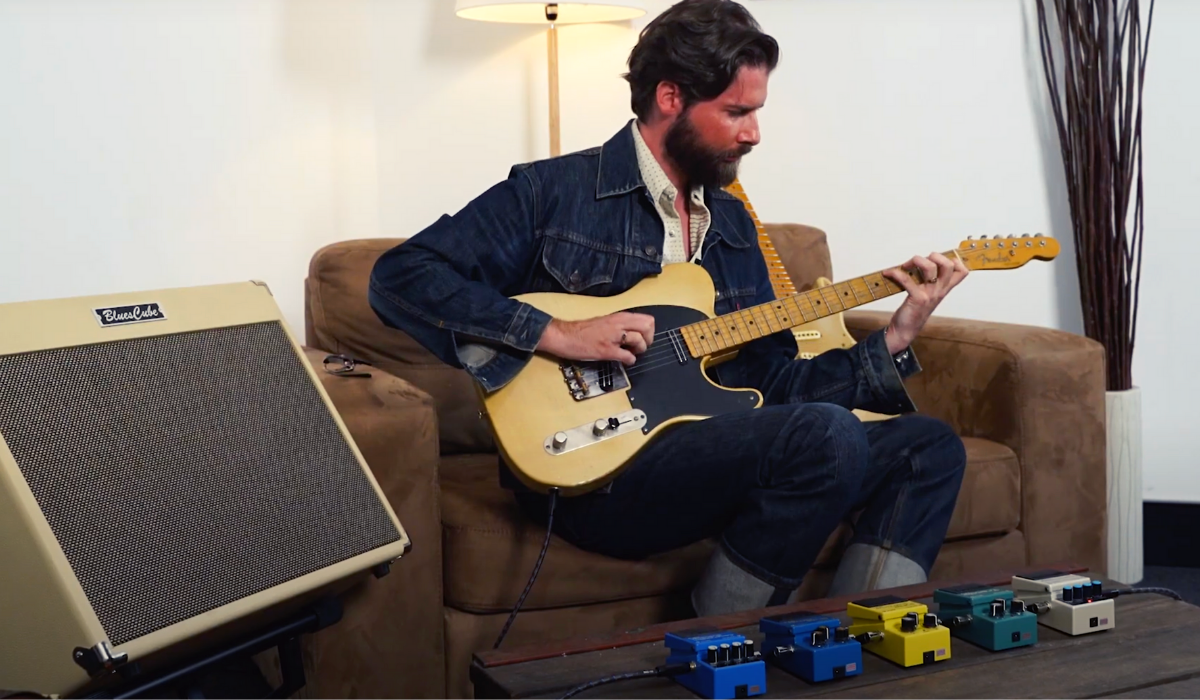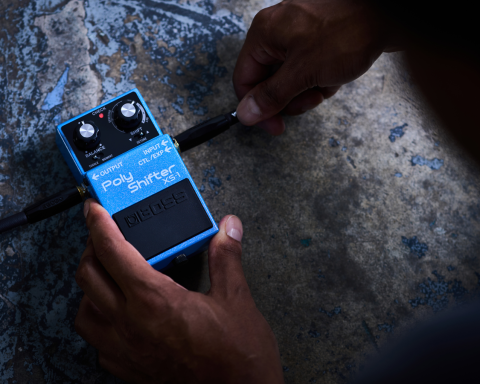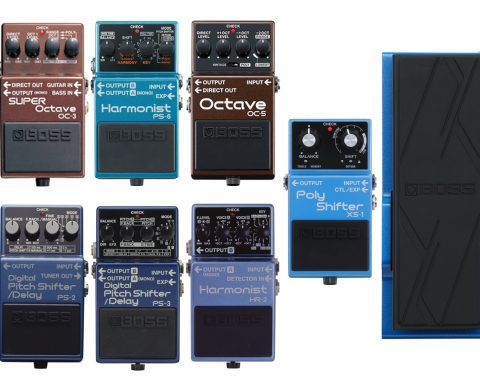Super clean with a glistening sheen, traditional country guitar evokes a jubilant social event full of pickin’ and twang. Think of the acoustic tones of seminal country guitarists Maybelle Carter and Jimmie Rodgers. Then there were the shimmering timbres of electric pioneers. Picture Bob Wills and the Texas Playboys (a Jimi Hendrix fave), Arthur Smith (1945’s “Guitar Boogie”), and the great Chet Atkins. These players suggest that early country guitar followed a “no additives allowed” mandate. But country players weren’t shy to add electronic embellishments to their sound. Experimentation by session players and renegades forged a path. Today’s country guitarists are often indistinguishable from their rock counterparts. Effects pedals played a large part in this shift.
Early Effects
Admittedly, early rockers and blues players may have taken a slight lead in recording enhanced guitar tones. They used distortion and overdrive—albeit in a relatively non-threatening way. Jackie Brenston & His Delta Cats got a bit gritty on “Rocket 88” in 1951. Howlin’ Wolf followed suit with “How Many More Years” in 1952. But country-influenced players also lined up. In 1956, the Paul Burlison of rockabilly act Johnny Burnette and the Rock ‘n Roll Trio showcased overdrive on “Honey Hush.” Former country guitarist Link Wray blew everything asunder with the menacing onslaught of “Rumble” in 1958.
A Fuzzy Story
These initial forays into guitar effects were due to somewhat natural events. These could include a dislodged or ailing tube or punching holes in a combo amp’s speaker. Things changed—at least for country music—when an electronic episode produced a fuzz tone on Marty Robbin’s 1961 single, “Don’t Worry.” Legendary Nashville session guitarist Grady Martin showed up to play a 6-string Danelectro bass on the song. During the session, a malfunctioning mixing console added a belligerent buzz to his solo spot at around 1:25. The faulty circuitry had a seismic impact on the evolution of guitar tone.
"Nashville guitarist Grady Martin showed up to play, and a malfunctioning console added buzz to his solo. It had a seismic impact on the evolution of guitar tone."
While Martin didn’t dig the effect at first, he ended up writing and recording an entire song around the effect, “The Fuzz,” in 1961. Glen Snoddy—who had engineered the track—was sought out by other artists and players looking to emulate Martin’s sound. This development was a surprise given how sonically tame most popular music was in the early 1960s.
Nashville Studio to British Invasion
The mixer channel ceased working, so Snoddy couldn’t use it to achieve similar results. However, he had the foresight to develop a device that could do the job. He partnered with another engineer, Revis Virgil Hobbs, to create a fuzz pedal using germanium transistors. Ultimately, the duo sold the circuit to Gibson, who manufactured and marketed the device as the Maestro FZ-1 Fuzz-Tone starting in 1962. Keith Richards used the pedal to power the most iconic fuzz riff of all time on the Rolling Stones’ 1965 hit, “(I Can’t Get No) Satisfaction.” From Nashville to England, the sound traveled from from country music makers to rock and roll’s bad boys.

"Country superstars like Vince Gill, Brad Paisley, Rebecca Lovell of Larkin Poe, and Keith Urban joined the pedal party."


Pickers and Pedals
It still took country guitarists a beat or two to embrace pedal effects. However, as country music styles evolved, pedals roared into Nashville with a vengeance. Session pros like Dann Huff, Reggie Young, and Brent Mason assembled rocker-like pedalboards. They populated them with boosters, compressors, delays, reverbs, EQs, distortions, and overdrives. Country superstars like Vince Gill, Brad Paisley, Rebecca Lovell of Larkin Poe, and Keith Urban joined the pedal party. These artists incorporated drives, delays, tremolos, compressors, reverbs, and modelers into their rigs.
The Heart of Country Guitar
With so many pedals, what keeps country guitar sounding country? It comes down to application. This, plus fingers, heart, and soul. Some rock, prog, and fusion players seek to obliterate the natural tone of the guitar. By contrast, in country, the approach is more subtle. One hears the effect, but listeners are also aware of the guitar’s pure tone. Ultimately, nothing should steal attention from the vocalist.
As a result, the essential pedals for country are delay, overdrive, and compressor. In the following play-throughs, Australian super picker Zane Banks demonstrates some techniques. Watch and learn how to deploy stompboxes into a “little bit country” mode.
DELAY
Slapback echo goes back to the ’50s, and it’s heard on early country, rockabilly, and rock tracks. Check out Chet Atkins’ “Blue Gypsy” or Scotty Moore on Elvis’ “Mystery Train.” Banks tends to keep his BOSS DD-3T Digital Delay active almost all the time to get a “beefier tone” for modern country. It brings a percussive quality to notes—what he calls “enhancing the aggressive spank.”
Drive
Few guitar performances are more jaw-dropping than a country chicken picker. Picture one blazing up and down the fretboard of a Fender Telecaster set as clear and clean as a fresh mountain snowpack. While such displays are otherworldly examples of technique, some pickers need extra oomph. Apparently, Banks likes to have his cake and eat it too. He shares his BOSS BD-2 Blues Driver setting for being able to go from “Where’s the overdrive?” to a ferocious gristle by using the volume knob.
Compression
A combo plate of fast licks performed on a Telecaster bridge pickup can make for a less-than-satisfying meal. For one thing, the bright, searing tone can be disturbing to some listeners. For another, poor performance dynamics can rob the listener of hearing every note pop. A compression pedal reduces the dynamic range of an input signal. The result is that everything sounds stout, balanced, and meaty.
Downward compression achieves this by reducing the level of loud sounds above a certain threshold. It leaves quiet sounds unaffected. Reverse the process for upward compression. The quieter sounds get boosted, while the loud ones remain loud. Whichever way a pedal works, you get a more musical array of guitar tones.
Banks uses his BOSS CS-3 Compression Sustainer as an enhancer. Still, he doesn’t leave it active throughout an entire performance. Instead, he uses compression to evoke the tones of Brent Mason, Albert Lee, and Ray Flacke. “If I’m playing Johnny Cash songs, that’s a kind of a ‘compressor-free zone,'” he says. “But for anything with that feel of ’80s and ’90s country music, I use the Compressor Sustainer.”
"A tremolo with a lot of reverb can take you to lonely town. It's the saddest thing I've ever heard." - Zane Banks
Tremolo
Whether you play country, rock, blues, or jazz, you should know that tremolo is a modulation effect. It rhythmically changes the volume of a signal. Vibrato, on the other hand, varies pitch. Tremolo can be quite an evocative effect when employed appropriately. Banks uses his BOSS TR-2 Tremolo sparingly. He feels too much of a good thing can swamp out the guitar sound. “But used at the right time in the right type of song, it really makes it,” he explains. “A tremolo with a lot of reverb can take you to lonely town. It’s the saddest thing I’ve ever heard.”
Super Overdrive
Contemporary country music honors its past, but, at times, it has to rock. There are moments at a Keith Urban concert where he wails like a fusion of Cream-era Eric Clapton, Stevie Ray Vaughan, and Eddie Van Halen. That doesn’t happen on a clean-toned Tele. An overdrive or distortion pedal is a critical component of country-shred extravaganzas. Banks uses a BOSS SD-1 Super Overdrive for what he calls “that ultra-British thing” when he plays his Gibson Les Paul. Fat tone. Saturation. Sustain for days. It’s where you want to be for soaring lead playing.
"Creative guitarists will always find ways to disrupt the status quo—regardless of the style they're supposed to play."

For many guitarists, effects pedals are little boxes of inspiration. The vast sound enhancements available by stepping on a footswitch can lead to new riffs, songs, and ideas. That bounty of sonic options is available to any guitarist. Indeed, creative types will always find ways to disrupt the status quo—regardless of the style they’re supposed to play. So, it makes little difference whether a country guitarist wants to play within musical conventions or blaze new trails. The dusty road to glory is underfoot within the circuitry of a stompbox.







